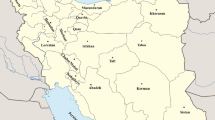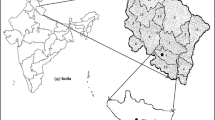Abstract
Iran is considered as one of the main centers of diversity of spinach species and one of the biggest producers, worldwide. However, there is no comprehensive information on the chromosomal characteristics of its wild species and the possible association of these indices with morphological and physiological features. The present study was conducted to analyze these characteristics in different populations of Iranian wild spinach compared to a commercial cultivar (Spinacia oleracea cv. Viroflay). The results showed that the seven spinach populations studied were diploids (2x = 2n = 12), and interestingly, the most of observed chromosomes were sub-metacentric. In case of morphophysiological traits, significant differences were observed for the most of measured traits and all morphological traits except number of leaves were higher in domestic species than the other two wild species. The results of physiological traits showed the highest content of anthocyanin and total chlorophyll, respectively, in Spinacia oleracea and S. tetrandra, and there was no significant difference among studied species for carotenoids content. In addition, the correlation coefficients showed significant correlations among chromosomal features, morphological characteristics and physiological traits. For example, with increase in the total length and the long arm of chromosomes, the number of leaves was increased and the content of chlorophyll a was decreased. Further, these species could be utilized in the breeding program to develop high yielding genotypes.




Similar content being viewed by others
References
Andersen SB, Torp AM (2011) Spinacia. In: Wild Crop Relatives: Genomic and Breeding Resources. Springer, pp 273–276
Arnon DI (1949) Copper enzymes in isolated chloroplasts. Polyphenoloxidase in Beta vulgaris Plant physiology 24(1):1
Asadi H, Hasandokht M (2007) Study of genetic diversity on Iranian spinach genotypes. Iranian Journal of Agricultural Sciences 38(2):257–265
Astley D, Ford-Lloyd B (1981) The evolutionary significance of multigermicity in the genus Spinacia (Chenopodiaceae). Plant Syst Evol 137(1–2):57–61
Brown RH, Bouton JH, Evans PT, Malter HE, Rigsby LL (1985) Photosynthesis, morphology, leaf anatomy and cytogenetics of hybrids between C3 and C3/C4Panicum species. Plant Physiol 77(3):653–658
Chen Q, Li HY (2005) An improved technique for high resolution mitotic chromosome studies in Solanum. HortScience 40(1):54–56
Decoteau DR (2000) Vegetable crops. vol 635 D3589v Ej. 1 025327. Prentice Hall
Ebadi-Segheloo A, Ali Asadi-Gharneh H, Mohebodini M, Janmohammadi M, Nouraein M, Sabaghnia N (2014) The use of some morphological traits for the assessment of genetic diversity in spinach (Spinacia oleracea L.) landraces. Plant Breeding and Seed Science 69(1):69–80
Ebrahim F, Pakniyat H, Arzani A, Rahimmalek M (2012) Karyotype analysis and new chromosome number reports in Achillea species. Biologia 67(2):284–288
Eftekhari S, Hasandokht M, Moghadam M, Kashi A (2010) Genetic diversity of some Iranian spinach (Spinacia oleracea L) landraces using morphological traits. Iranian Journal of Horticultural Science. 41(1):83–93
Ellis JR, Janick J (1960) THE CHROMOSOMES OF SPLNACIA OLERACEA. Am J Bot 47(3):210–214. https://doi.org/10.1002/j.1537-2197.1960.tb07115.x
Fujito S, Takahata S, Suzuki R, Hoshino Y, Ohmido N, Onodera Y (2015) Evidence for a common origin of homomorphic and heteromorphic sex chromosomes in distinct Spinacia species. G3: Genes, Genomes, Genetics. 5 (8):1663–1673
Huziwara Y (1962) Karyotype analysis in some genera of Compositae VIII Further studies on the chromosomes of Aster. American Journal of Botany. 49(2):116–119
Ito M, Ohmido N, Akiyama Y, Fukui K, Koba T (2000) Characterization of spinach chromosomes by condensation patterns and physical mapping of 5S and 45S rDNAs by FISH. J Am Soc Hortic Sci 125(1):59–62
Kallo G, Bergh B (1993) Genetic improvement of vegetable crop. Percamon Press, Oxford and New York
Khoury CK, Achicanoy HA, Bjorkman AD, Navarro-Racines C, Guarino L, Flores-Palacios X, Engels JM, Wiersema JH, Dempewolf H, Sotelo S (2016) Origins of food crops connect countries worldwide. Proceedings of the Royal Society B: Biological Sciences 283(1832):20160792
Krizek DT, Kramer GF, Upadhyaya A, Mirecki RM (1993) UV-B response of cucumber seedlings grown under metal halide and high pressure sodium/deluxe lamps. Physiol Plant 88(2):350–358
Kunitake H, Nakashima T, Mori K, Tanaka M (1998) Somaclonal and chromosomal effects of genotype, ploidy and culture duration in Asparagus officinalis L. Euphytica 102(3):309
Lavania U, Srivastava S (1999) Quantitative delineation of karyotype variation in Papaver as a measure of phylogenetic differentiation and origin. Current Science. 7:429–435
Levan A, Fredga K, Sandberg AA (1964) Nomenclature for centromeric position on chromosomes. Hereditas 52(2):201–220
Morelock TE, Correll JC (2008) Spinach. In: Vegetables I. Springer, pp 189–218
Nešković M, Ćulafić L (1988) Spinach (Spinacia oleracea L.). In: Crops II. Springer, pp 370–385
Nonnecke IL (1989) Vegetable production. Springer Science & Business Media,
Pandey S, Kalloo G (1993) Spinach: Spinacia oleracea L. In: Genetic Improvement of Vegetable Crops. Elsevier, pp 325–336
Prior R Spinach as a source of antioxidant phytochemicals with potential health effects. In: National Spinach Conference, Fayetteville, AR. USA, November, 2003.
Reeves A, Tear J (2000) MicroMeasure for Windows, version 3.3. Free program distributed by the authors over the Internet from.
Ryder EJ (1979) Leafy salad vegetables. Springer Science & Business Media,
Sarikhani Khorami S, Vahdati K (2019) Determination of Persian walnut yield components and its correlation with phenological, morphological and biochemical traits. Iranian Journal of Horticultural Science 50(3):549–560
Shubha K, Singh D (2018) Selection of Yield-Associated Morphological and Biochemical Traits Using Correlation and Path Coefficient Analysis in Potato (Solanum tuberosum L) in the Foothills of North-Western Himalayas. Potato Research. 61(3):273–281
Stace CA (1991) Plant taxonomy and biosystematics. Cambridge University Press
Stagnari F, Di Bitetto V, Pisante M (2007) Effects of N fertilizers and rates on yield, safety and nutrients in processing spinach genotypes. Sci Hortic 114(4):225–233
Stebbins GL (1971) Chromosomal changes, genetic recombination and speciation. Chromosomal evolution in higher plants. 3:72–123
Wang L-J, Sheng M-Y, Wen P-C, Du J-Y (2017) Morphological, physiological, cytological and phytochemical studies in diploid and colchicine-induced tetraploid plants of Fagopyrum tataricum (L) Gaertn. Botanical studies. 58(1):2–6
Zarco CR (1986) A new method for estimating karyotype asymmetry. Taxon 35(3):526–530
Author information
Authors and Affiliations
Corresponding author
Additional information
Publisher's Note
Springer Nature remains neutral with regard to jurisdictional claims in published maps and institutional affiliations.
Supplementary Information
Below is the link to the electronic supplementary material.
Rights and permissions
About this article
Cite this article
Nasrabadi, M.D., Hassandokht, M., Mirahmadi, S.F. et al. Evaluation of Diversity in Spinach Populations based on Cytogenetical Characteristics and their Relation with Morphological and Physiological Traits. Agric Res 11, 175–184 (2022). https://doi.org/10.1007/s40003-021-00569-5
Received:
Accepted:
Published:
Issue Date:
DOI: https://doi.org/10.1007/s40003-021-00569-5




